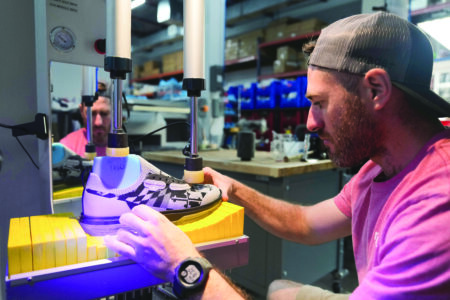Cops see progress but opioids remain massive problem
PETOSKEY — It wasn’t that long ago when pharmacies become targets for those who became addicted to opioids.
“You don’t hear too much about that now,” said Michigan State Police Detective Lt. Ken Mills, who serves as unit commander of Straits Area Narcotics Enforcement.
“We also were getting calls where people were going to a pain clinic, were getting scripts and people were following them to pharmacies and approaching them about buying their script.
“It’s been a problem for a long time,” Mills added. “But there’s been some good steps made over the years.”
The diversion of prescription drugs and heroin continue to be the biggest problems SANE faces, Mills said, and the diversion of prescription opiates is directly related to heroin activity.
SANE is a multi-jurisdictional drug task force, governed under an agreement among Cheboygan, Emmet and Otsego counties and the Michigan State Police.
According to SANE’s 2017 annual report, heroin delivery counts significantly increased in 2017, from 17 in 2016 to 26 last year.
Also, the counts for delivery of prescription drugs remained very high, with 98 being counted for for opiates. SANE’s arrest counts have declined over the past three years, from 417 in 2015 to 337 in 2016 and 317 last year.
Prescription opiates have been the most common substances involved in SANE cases in each of the last two years, falling from 44 in 2016 to 38 in 2017.
“It started in the late ’90s with OxyContin and prescriptions and it just took off from there,” Mills said.
Opioids, such as Norco, Vicodin, morphine, OxyContin and Demerol, are being abused throughout Northern Michigan, typically obtained via a prescription from a physician and filled throughout pharmacies in the area, Mills said.
“A lot of stuff we’re buying on the streets, we’re never buying a lot of opioids that were stolen from grandparents or someone’s parents,” Mills said. “They were never stolen or as a result from someone that’s passed away.”
Michigan State Police Trooper Corey Hebner, who is based at the agency’s Gaylord post, said the biggest problem with the opioid crisis is the drugs are addicting and hooking people who never had intentions to use the drug recreationally.
“The statistic is some 80 percent of today’s heroin addicts started on an opioid-based pain killer,” Hebner said. “It’s not the transgression of alcohol to marijuana to the harder stuff, it’s ‘I got Oxy from my dentist because he pulled my wisdom teeth and I took these 20 or 40 tabs and got addicted,’ or ‘I was in a car accident and got addicted.’
“We’re seeing a ton of people who are becoming addicts who never had the intention of abusing drugs recreationally,” Hebner added. “That’s the big change and just how addictive these opioids are.”
In many cases, Mills noted, the drugs are being sold as a way to make money, or because there’s a lack of understanding or knowledge of the severity of them.
“It’s still common where older people are approached by someone about buying their scripts,” Mills said. “With older folks, if they see they can sell a small amount of their prescription and make some money, they can pay their bills. People will take advantage of their (older population) financial situation or lack of information or knowledge of the abuse of opioids.”
Mills said SANE purchases more prescription pills than any other MJTF (multijurisdictional task force) in the state, and part of that reason is the force’s success with other drugs.
“One of the things with prevention efforts is, once things started working and you have an impact on pills, you’d see an increase in heroin, which we did,” Mills said. “That height was around 2013-14 and we started seeing a lot more of it in that period and that’s closely tied to opioids.”
After working with other sources and task force teams, SANE helped identify suppliers from Kalamazoo and Detroit and numbers have steadily decreased as of late.
“Like most areas most heroin we were seeing was mixed with fentanyl and sold as heroin,” Mills said. “We never saw the carfentanyl, but it was common to see the fentanyl mixed. Now, we’re just not seeing that much of it which is good, but we still always have the pills available.”
Mills said opioids are a high priority for SANE.
“It will be an issue because doctors try to do what they can and they have to be dependent on their patients,” Mills said. “They’re trying to make their patients better and dealing with different types of pain they’re having.”
Hebner said the doctor-patient relationships can be a slippery slope.
“If you’re a doctor you’re rated on Yelp on pain management,” Hebner said. “They’re trying to treat people and their pain, it’s not like they’re trying to get people addicted.”
In December 2018, Lt. Governor Brian Calley signed into law a 10-bill package from the Michigan Legislature aimed at curbing the state’s persistent and increasing substance abuse and drug diversion problem.
Public Act 251, which went into effect July 1, states that if a prescriber is treating a patient for acute pain, the prescriber is not to prescribe the patient more than a 7-day supply of an opioid within a 7-day period.
Public Act 254, which also went into effect July 1, focuses on steps to educate students about the dangers of prescription opioid abuse. It requires the Prescription Drug and Opioid Abuse Commission (PDOAC) to develop or adopt recommendations for the Department of Education focusing on these. By July 2019, the Department of Education would need to make the model instruction program available to school districts.
Peter Bucci, a clinician with substance abuse treatment provider Harbor Hall in Petoskey, said it’s a very normal practice to be prescribed a painkiller of some kind to deal with pain after your body undergoes a medical procedure.
“The problem occurs when there’s no physical therapy or secondary type of treatment prescribed in addition to the medication which helps with symptoms,” Bucci said. “Because of them, people are unaware they should be tapering themselves off medications.”
Bucci said depending on the time of year, Harbor Hall has nearly a 50-50 split of patients suffering from problems with alcohol and other drugs.
“There is more of an influx of things being added to the opioid list, which makes the crisis more scary or real,” Bucci said. “The adding of things like fentanyl, carfentanyl has actually increased over the years, whereas before is was just straight heroin or mixing medications.
“Now, we’re starting to see clients who are dabbling into fentanyl or carfentanyl.”
Those who have an opioid addiction can be at any stage of life, Bucci added, with the average client at Harbor Hall between the ages of 30-50.
“If the public was aware of the prevalence of substances, hard substances, available out there they’d be quite shocked,” Bucci said. “It’s available. If you wanted it and found the right people, it’s a lot more prevalent than people know.”
Mills said Northern Michigan communities are fortunate to have options such as Harbor Hall, Catholic Human Services and the Michigan State Police Angel Program — which allows people in need of drug treatment to seek it out via a state police post without fear of arrest — to help combat the opioid problem.
“I think more people know opioids are a problem and should be taken as prescribed by a physician,” Mills said. “They affect everyone is some way, shape or form.”
Follow Steve Foley on Twitter @SteveFoley8





